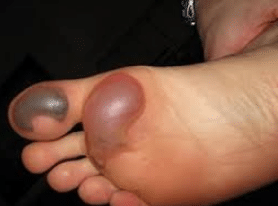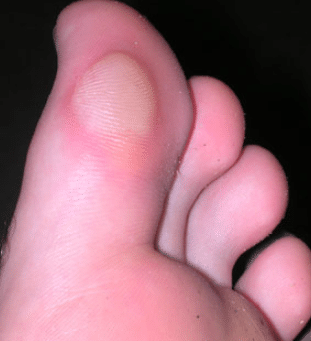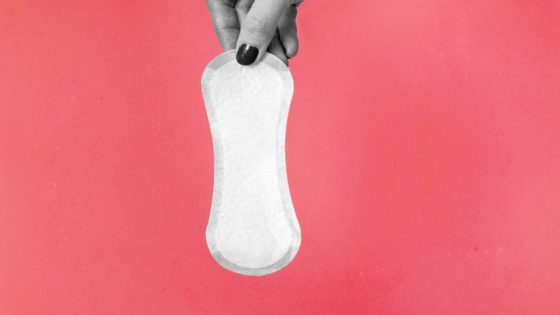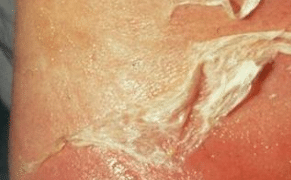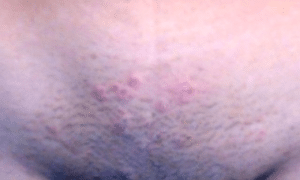Do dyshidrotic eczema feet cause blisters? What is a blister? How long does it take for a blister to heal? Get more insight into the causes, blisters between the toes, both water and blood filled blisters, blisters that itch and how to cure them fast.
Blister on Bottom of Foot Causes
The causes include:
- Friction
Friction is one of the most common causes of blisters on the feet. The rubbing together of the skin of feet and new or poorly fitted shoes result in the development of blisters that are water filled. The formation of the blisters on the toes is common when the feet are moist and warm rather than when it is dry.
The constant friction that is intense on the toes could result in foot corns or calluses. Painful blisters on the bottom of the feet could hinder an individual from walking or running faster. It is therefore recommended to consult a medical professional when the bottom of the foot become sore.
- Heat
Formation of blisters can also develop from intense heat caused by:
- Burns
First-degree heat will result in the formation of blisters that will last for a couple of days before healing on its own. The second degree will result in blisters that pop immediately and become sore.
- Sunburn
Prolonged exposure to UV rays from the sun will result in the formation of the blisters. According to the research, sunburn causes blistering of the feet skin and it can be painful to some extent.
- Cold
The tissue of the skin that is damaged from frostbite can also cause blisters on feet. Exposure to temperatures below freezing point can cause blood vessels to contract to push blood away from the extremities, especially the hands and feet in an attempt to keep us warm. This can lead to skin tissue damage and even death.
Since frostbite occurs in different stages, it can also result in the formation of blisters on the feet and it is recommended to find some appropriate ways on how to get rid of them immediately before they become painful sores on the feet.
- Exposure to chemicals
There are some chemical ingredients that are found in the solvents, detergents or cosmetics and when they can into contact with the feet skin, it can result in the formation of painful blisters. Therefore, it is recommended to wear gloves when using some chemicals since they cause skin irritation.
- Medical condition
An individual with a certain type of medical conditions such as chicken pox, shingles, herpes, impetigo, cold sores, scabies and some forms of eczema can result in the formation of blisters. Therefore, it is recommended to identify the root cause of the blisters before adopting any form of treatment.
- Dyshidrotic Eczema
This is a skin condition that results in the formation of small blisters on the bottom of the feet and palms of the hands. According to the research conducted by MedlinePlus, dyshidrotic eczema is more common in women than men.
- Althlete’s Foot Infection
The medical term for the condition is tinea pedis, and it can result in the formation of small blisters on the feet. According to MedlinePlus, an athlete’s foot infection occurs when a particular type of fungus grows on the skin and it later results in skin itch around the toes.
- Poison Ivy
Contact dermatitis can cause small blisters to form on the bottom of the feet in response to an allergic reaction. Blisters can also form in reaction to poison ivy if the bottom of the foot is exposed.
Several rarer conditions can also cause blisters. Some of the conditions include:
- Bullous pemphigoid -which is a skin condition that results in the development of large blisters on the foot.
- Pemphigus vulgaris– this is a condition that develops due to excessive application of pressure that results in the formation of blisters.
- Dermatitis herpetiformis– a skin condition that causes intensely itchy blisters and according to the studies, blisters usually develop in patches of the same shape and size on both sides of the body.
- Chronic bullous dermatosis of childhood – a condition that causes clusters of blisters to develop on the face, mouth or genitals
- Bullous ichthyosiform erythroderma – a type of ichthyosis someone is born with, which causes inflamed, scaly skin with blisters
Little Blisters on Bottom of Foot
Athlete’s foot is a condition that results in the formation of littles blisters in between the toes and it is due to fungal infection. This condition is quite common among all humans not only among children.
The foot infection is contagious and can be passed from one person to another through direct contact with infected people, infected animals, contaminated objects (such as towels or locker room floors), or the soil.
The following are some of the conditions that make the formation of little blisters to occur among people:
- Living in warm, humid climates
- Using public or community pools or showers
- Wearing tight, non-ventilated footwear
- Sweating profusely
- Having diabetes or a weakened immune system
Water Blisters on Bottom of Feet
The medical term for water blister is vesicle to refer to a raised portion of skin that is filled with fluid. The most common cause for the formation of blisters on the feet is friction between the skin of feet and the shoes.
Blisters formation on the feet can create a lot of discomfort and pain but it is not a symptom of anything serious and will heal without any medical intervention.
The common causes of water blisters include:
- Contact dermatitis
This is a condition that occurs when the skin reacts to some allergens like poison ivy, latex, adhesives, or irritants like chemicals or pesticides. These allergens can result in the appearance of red, inflamed and blistering skin around the toes of the feet.
- Burns
Intense or severe burn can result in the formation of the blisters on the feet. The common sources of burns are heat, chemicals, and sunburns.
- Allergic eczema
This is a skin condition that results in the formation of blisters due to skin reaction to some allergens. Another form of eczema known as dyshidrotic eczema can also result in the formation of blisters but the cause of the condition is unknown.
However, having blisters on the bottom of the foot, around the mouth and hands could be the symptom of the following condition:
- Impetigo which is a bacterial infection that results in the formation of blisters among both adults and children.
- Chickenpox this is a viral infection on the skin that causes itchy spots, and often blisters on the skin.
Other rare conditions include:
- porphyrias
- Pemphigus
- Dermatitis herpetiformis
- Epidermolysis bullosa
- Erysipelas
- Shingles or herpes zoster
Blisters on Bottom of Feet That Itch
The appearance of blisters on the feet can be caused by different factors. Some of these blisters are known to be caused by poison ivy, athlete’s foot, and hand foot & mouth. Some causes can be infectious while others can be non-infectious.
- Poison Ivy
This form of cause is said to be non-infectious and it results in the formation of bumps or blisters which itch. Sometimes these blister open and crust. These blisters occur due to the reaction of the body from the resin from plants.
- Athlete’s Foot
The feet condition is marked by the formation of a scaly, itchy rash. This is caused by a fungus which likes to live in warm, moist places. This type of rash is most commonly found in teens and young males.
- Hand Foot and Mouth Disease
The condition is said to be infectious and it is marked by the formation of small blisters like bumps on the feet and soles. It is caused by a virus and is common and very contagious in younger children.
Blisters on Bottom of Toes
The appearance of blisters on the feet and toes has become a common problem and in most cases, it results in foot pain. Most of these blisters are caused by friction and sometimes due to infection, burns and chemical exposure.
Most blisters appear to have fluid filled substances known as plasma but can sometimes contain blood or pus. These blisters develop when the skin around the feet is damaged due to friction and in the process; it forms blisters to protect it from further damage.
Some of the other common causes of these blisters on the toes and feet include:
- Frostbite
- Allergic reaction
- Chemical exposure (cosmetics or detergents)
- Fungal infections
- Chickenpox
- Bacterial infection
- Herpes
- Dyshidrotic eczema
Deep Blisters on Bottom of Feet
Deep blisters on the bottom of the foot are caused by numerous factors. Some of the common cause’s ranges from several types of inflammatory conditions of the skin, allergic reactions, to sometimes bacterial, viral or fungal infections can cause blisters on the skin.
According to some studies, insect bites can also result in the formation of blisters. Therefore, it is recommended to have these blisters examine by a medical professional for treatment.
Unexplained Blisters on Feet
The appearances of blisters on the feet are mostly caused by friction from tight shoes, herpes, chicken pox, poison ivy and allergic reactions. Less common causes are disorders that only cause blisters on the hands and feet.
- Hand-Foot-Mouth Disease
Hand-foot-mouth infection, or HFMD, causes rashes on the hands and feet. It’s an infectious issue caused by contamination that spreads through direct contact with infected saliva, liquid from blisters and stool.
HFMD ordinarily starts with a sore throat and ulcerations on the tonsils, throat, tongue, and mouth. The palms of the hands and bottoms of the feet grow little; agonizing blisters with white focus and red outskirts.
- Pompholyx
Pompholyx is an endless skin condition that causes irritated rankle on the palms, the sides of the fingers and the feet. The blisters are commonly flaky and red with overflow liquid. The reason for pompholyx is obscure or still unknown.
- Localized Epidermolysis Bullosa Simplex
Restricted epidermolysis bullosa simplex is an acquired issue portrayed by skin blistering. The turmoil normally starts when a kid who conveys the qualities for the confusion starts to walk.
Normally restricted to the hands and feet, blisters shape when the best layer of the skin isolates from the connective tissue underneath it when presented to grinding, warm or mellow injury.
Other causes of unexplained blisters on the feet and hands include:
- Primary irritants
- Skin inflammation due to allergic contact with substance such as poison ivy or poison oak
- Sunburn
- Burns
- Insect bites
- Viral infections such as herpes or varicella
- Severe systemic conditions that require immediate medical attention
Blisters on Bottom of Foot That Hurt To Walk
Blisters show up when an individual wear fitting shoes or jeans rub against the skin. After some time, this erosion makes the external layer of skin isolate from the inward layers, shaping a pocket between the layers.
Detecting disturbance, the body reacts by making lymph liquid to grease up the region. The pocket loads with this lymph liquid and makes the natural air pocket known as a blister. This sort of blister is generally large in response to ill-fitting shoes, disgraceful shoes with huge inside creases and sweat.
Blisters on the base of the feet are probably going to be caused by the foot sliding forward and backward in an as well vast shoe in the mix with the warm, wet conditions caused by sweat.
Blood blisters are comparable in real life and appearance to normal blisters, however, are red in shading because of blood that has spilled into the lymph and tissues in light of strain or injury. This sort of blister demonstrates that a vein has been harmed or broken by an effect or squeeze, perhaps notwithstanding the making of a typical blister.
These blisters are not hazardous, but rather they are an indication that a bigger level of disturbance might be available. A blood blister on the base of the foot is most likely an indication of a sudden effect.
Itchy Blisters on Feet Not Athlete’s Foot
Itchy blisters are formed due to numerous reasons. It may only affect a small area, be short-lived and mild, or it may spread further up the leg, return frequently and be painful or itchy.
Here are some of the most common causes of blistering on the skin around the soles and feet. The causes include:
- Psoriasis
This is a skin condition marked by red, scaly, itchy patches. It is caused by rapid overproduction of skin cells due to a problem with the immune system. Psoriasis skin lesions range from small, localized patches to major eruptions affecting the whole body. A foot rash from psoriasis tends to occur on the soles of the feet.
- Scabies
It is a contagious skin condition caused by a parasite burrowing under the skin. It causes intense itching which is worse at night. Superficial burrows from the site through the skin appear in lines accompanied by small, red spots commonly in the webs of fingers and toes, producing a hand or foot rash.
- Insect Bite
A bite to the foot or ankle can produce a blister or a pimple. It tends to be a small, localized spot or group of spots which are itchy and settle within a few days.
Other Causes
- Atopic Dermatitis
- Irritant Contact Dermatitis
- Allergic Contact Dermatitis
- Hand, Foot & Mouth Disease
Large Blisters on Bottom of Feet
Blisters are fluid-filled pockets on the surface of the skin, which form due to friction or burns. They are most common in the feet and hands. While most blisters will heal by themselves without any need for home treatment, larger, more painful blisters may need a little help along the way.
Some of best ways on how to handle these large blisters on the bottom of the feet include:
- Leave the blister intact if it is not painful.
- Drain the blister if it is causing you pain.
- Clean the area with soap and water
- Sterilize a needle
- Puncture the blister
- Apply some antibacterial ointment
- Loosely cover with a gauze pad or bandage.
- Cut away any dead skin and re-bandage.
How to Cure Blisters on Feet Fast
The remedies for getting rid of blisters on bottom of feet include:
- Apply tea tree oil
It has antibacterial and astringent properties that help to get rid of any bacterial infections and dry out the blister. Use a Q-tip to dab a little of the oil onto a drained or lanced blister once a day, before applying a fresh bandage
- Use apple cider vinegar
It has antibacterial properties that help to ward off any infection on minor injuries like those caused by blisters. Apply diluted cider vinegar on the blisters using a q-tip to dab it.
- Apply aloe vera
It has a gel that has soothing and healing properties. It is a natural anti-inflammatory and moisturizer, making it a great option for blisters caused by burns. To use, break off a leaf from the plant and rub the clear, gel-like sap over and around the blister. This is especially useful once the blister has popped, as it will speed up the healing process.
- Soak in green tea
It has natural anti-inflammatory properties, so soaking the blistered skin in a bowl or basin of cooled green tea can help to soothe swollen or inflamed skin around the blister.
- Use vitamin E
It allows the skin to heal faster and helps to prevent scarring. It can be found in both oil and cream form at the drugstore. Simply smooth a little over the blistered skin each day to promote healing.
- Make a chamomile compress
It has soothing qualities and can help to ease the pain of a swollen blister. Make a strong cup of chamomile tea, allowing it to brew for five to six minutes. Once it has cooled slightly, dip a clean washcloth into the tea until soaked, and then wring out the excess moisture. Press this warm compress against the blister for about ten minutes, or until the pain subsides.
- Soak in Epsom salts
Epsom salts help to dry out an unpopped blister and encourage it to drain. Simply dissolve some Epsom salts in a hot bath and allow the blister to soak. Be careful though, once the blister has burst the Epsom salts will sting.
How to Get Rid Of Water Blisters on Feet
It is recommended not to drain blisters at home, but when the condition becomes painful, an individual may prefer to remove the fluid. In such cases, the following steps must be followed:
- Properly rinse your hands using good quality soap and lukewarm water.
- Apply iodine on a swab and clean the blister area with it.
- The needle which is to be inserted into blister should be thoroughly cleaned and sterilized with alcohol or other antiseptic agents.
- Puncture the blister using a sterilized needle. Don’t pinch in the center of the blister; instead, aim for the edges. Once the needle is inserted, allow the fluid from the blister to drain, but do not remove the overlying skin.
- Once you drain the fluid, use an antibacterial ointment such as Vaseline and apply gently over the blister. Then cover it with gauze.
- Be sure to change the dressing every day, until the blister heals completely.
FURTHER REFERENCES AND SOURCES
- Blisters On Feet: http://www.foot-pain-explored.com/blisters-on-feet.html
- Causes of blisters: http://www.nhs.uk/Conditions/Blisters/Pages/Causes.aspx
- Causes of Blisters on the Bottom of the Foot: http://www.livestrong.com/article/225152-causes-of-blisters-on-the-bottom-of-the-foot/
- What causes water blisters to form on the hands and feet? https://www.zocdoc.com/answers/3607/what-causes-water-blisters-to-form-on-the-hands-and-feet
- How to Treat Blisters Under the Ball of Your Foot: http://www.newhealthadvisor.com/blisters-on-bottom-of-feet.html
- Healing Home Cures for Blisters: https://www.everydayhealth.com/foot-health-pictures/healing-home-cures-for-blisters.aspx#02


